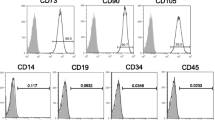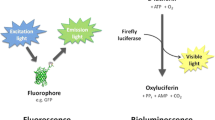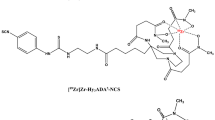Abstract
Purpose
This study was performed to evaluate the effect of 111In-labeling on the cell growth, cycle and viability of bone marrow mesenchymal stem cells (BMSCs).
Methods
Rat BMSCs were labeled with various doses of 111In (0.4–11.1 Bq/cell). The growth curve of 111In-BMSCs was obtained up to 14th day of labeling. The cell cycle was evaluated by 5-bromo-2-deoxyuridine (BrdU) labeling or propidium iodide (PI) staining. Senescent cells were counted under a light microscope after staining with 5-bromo-4-chloro-3-indolyl-D-galactopyranoside. Flow cytometry was performed to measure apoptotic and necrotic fractions after staining with annexin V-FITC and PI.
Results
The growth of BMSCs labeled with higher doses of 111In (4.4 or 11.1 Bq/cell) was significantly inhibited from the 3rd day of labeling. Flow cytometry revealed less BrdU-positive BMSCs at 11.1 Bq 111In/cell during all measurement days and G1 arrest at 4.4 and 11.1 Bq 111In/cell. Significant increases in apoptosis and necrosis were also observed at 4.4 (3.04%/1.35%) and 11.1 Bq 111In/cell (9.07%/3.18%) on the 14th day (control = 1.60%/0.39%). However, no cellular senescence was visualized up to the 14th day.
Conclusion
A high dose of 111In-labeling induced cell cycle arrest and death in BMSCs; therefore, it should be used with a careful dosimetry in case of applying it to humans.




Similar content being viewed by others
References
Raval AN, Kamp TJ, Hogle LF. Cellular therapies for heart disease: unveiling the ethical and public policy challenges. J Mol Cell Cardiol. 2008;45(4):593–601.
Chen SL, Fang WW, Ye F, Liu YH, Qian J, Shan SJ, et al. Effect on left ventricular function of intracoronary transplantation of autologous bone marrow mesenchymal stem cell in patients with acute myocardial infarction. Am J Cardiol. 2004;94(1):92–5.
Bang OY, Lee JS, Lee PH, Lee G. Autologous mesenchymal stem cell transplantation in stroke patients. Ann Neurol. 2005;57(6):874–82.
Flores-Ramirez R, Uribe-Longoria A, Rangel-Fuentes MM, Gutierrez-Fajardo P, Salazar-Riojas R, Cervantes-Garcia D, et al. Intracoronary infusion of CD133+ endothelial progenitor cells improves heart function and quality of life in patients with chronic post-infarct heart insufficiency. Cardiovasc Revasc Med. 2010;11(2):72–8.
Yang Z, Zhang F, Ma W, Chen B, Zhou F, Xu Z, et al. A novel approach to transplanting bone marrow stem cells to repair human myocardial infarction: delivery via a noninfarct-relative artery. Cardiovasc Ther. 2010;28(6):380–5.
Bengel FM, Schachinger V, Dimmeler S. Cell-based therapies and imaging in cardiology. Eur J Nucl Med Mol Imaging. 2005;32 Suppl 2:S404–16.
Barbash IM, Chouraqui P, Baron J, Feinberg MS, Etzion S, Tessone A, et al. Systemic delivery of bone marrow-derived mesenchymal stem cells to the infarcted myocardium: feasibility, cell migration, and body distribution. Circulation. 2003;108(7):863–8.
Hofmann M, Wollert KC, Meyer GP, Menke A, Arseniev L, Hertenstein B, et al. Monitoring of bone marrow cell homing into the infarcted human myocardium. Circulation. 2005;111(17):2198–202.
Chin BB, Nakamoto Y, Bulte JW, Pittenger MF, Wahl R, Kraitchman DL. 111In oxine labelled mesenchymal stem cell SPECT after intravenous administration in myocardial infarction. Nucl Med Commun. 2003;24(11):1149–54.
Caveliers V, De Keulenaer G, Everaert H, Van Riet I, Van Camp G, Verheye S, et al. In vivo visualization of 111In labeled CD133+ peripheral blood stem cells after intracoronary administration in patients with chronic ischemic heart disease. Q J Nucl Med Mol Imaging. 2007;51(1):61–6.
Yoon JK, Park BN, Shim WY, Shin JY, Lee G, Ahn YH. In vivo tracking of 111In-labeled bone marrow mesenchymal stem cells in acute brain trauma model. Nucl Med Biol. 2010;37(3):381–8.
Jin Y, Kong H, Stodilka RZ, Wells RG, Zabel P, Merrifield PA, et al. Determining the minimum number of detectable cardiac-transplanted 111In-tropolone-labelled bone-marrow-derived mesenchymal stem cells by SPECT. Phys Med Biol. 2005;50(19):4445–55.
Bindslev L, Haack-Sorensen M, Bisgaard K, Kragh L, Mortensen S, Hesse B, et al. Labelling of human mesenchymal stem cells with indium-111 for SPECT imaging: effect on cell proliferation and differentiation. Eur J Nucl Med Mol Imaging. 2006;33(10):1171–7.
Chen MF, Lin CT, Chen WC, Yang CT, Chen CC, Liao SK, et al. The sensitivity of human mesenchymal stem cells to ionizing radiation. Int J Radiat Oncol Biol Phys. 2006;66(1):244–53.
Schonmeyr BH, Wong AK, Soares M, Fernandez J, Clavin N, Mehrara BJ. Ionizing radiation of mesenchymal stem cells results in diminution of the precursor pool and limits potential for multilineage differentiation. Plast Reconstr Surg. 2008;122(1):64–76.
Riggi N, Cironi L, Provero P, Suva ML, Kaloulis K, Garcia-Echeverria C, et al. Development of Ewing’s sarcoma from primary bone marrow-derived mesenchymal progenitor cells. Cancer Res. 2005;65(24):11459–68.
Palestro CJ, Brown ML, Forstrom LA, McAfee JG, Royal HD, Schauwecker DS et al. Society of Nuclear Medicine Procedure Guideline for 111In-Leukocyte Scintigraphy for Suspected Infection/Inflammation. 2004. http://interactive.snm.org/docs/Leukocyte_v3.pdf
Gholamrezanezhad A, Mirpour S, Bagheri M, Mohamadnejad M, Alimoghaddam K, Abdolahzadeh L, et al. In vivo tracking of (111)In-oxine labeled mesenchymal stem cells following infusion in patients with advanced cirrhosis. Nucl Med Biol. 2011. doi:10.1016/j.nucmedbio.2011.03.008.
Singh S, Kloss FR, Brunauer R, Schimke M, Jamnig A, Greiderer-Kleinlercher B, et al. Mesenchymal stem cells show radioresistance in vivo. J Cell Mol Med. 2011. doi:10.1111/j.1582-4934.2011.01383.x.
Gildehaus FJ, Haasters F, Drosse I, Wagner E, Zach C, Mutschler W, et al. Impact of indium-111 oxine labelling on viability of human mesenchymal stem cells in vitro, and 3D cell-tracking using SPECT/CT in vivo. Mol Imaging Biol. 2011;13(6):1204–14.
Brenner W, Aicher A, Eckey T, Massoudi S, Zuhayra M, Koehl U, et al. 111In-labeled CD34+ hematopoietic progenitor cells in a rat myocardial infarction model. J Nucl Med. 2004;45(3):512–8.
Acknowledgements
This work was supported by a Korea Research Foundation Grant funded by the Korean Government (MOEHRD, Basic Research Promotion Fund) (KRF-2008-313-E00446) and by 2008 grant from Department of Medical Sciences, The Graduate School, Ajou University (Yoon J.K.).
Conflicts of Interest
None.
Author information
Authors and Affiliations
Corresponding author
Rights and permissions
About this article
Cite this article
Park, BN., Shim, W., Ahn, Y.H. et al. High-Dose 111In Induces G1 Cell Cycle Arrest and Cell Death in Rat Bone Marrow Mesenchymal Stem Cells. Nucl Med Mol Imaging 46, 81–88 (2012). https://doi.org/10.1007/s13139-011-0124-6
Received:
Revised:
Accepted:
Published:
Issue Date:
DOI: https://doi.org/10.1007/s13139-011-0124-6




